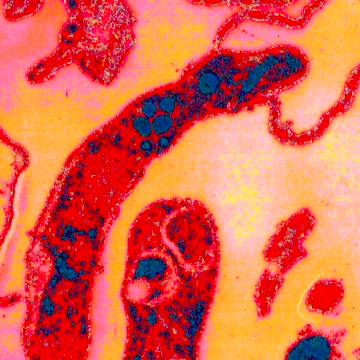
Adaptation
At a glance Cryptosporidium parvum does
not appear to be a complex organism. However, don’t let its size
fool you. There are many interesting ways in which this
unicellular organism has adapted to its environment. These
adaptations have allowed in to survive in our chemically treated
water systems, infect our intestines, and its small size makes
it hard to detect in a public water system! This page will
describe these unique adaptations of Cryptosporidium parvum to
the environments in which it lives.

First, the adaptation of C.parvum small size allows it to move
from fecal waste to our intestines. The adaptation of a 4-6 µm (
µm stands for micrometer) oocysts allows the organism to be
environmentally stable in most commonly water and fecal water
(Yakub and Stadterman-Knauer, 2004). Because of this small size,
it is easily transmissible from contaminated water to a mammals
digestive tract. C. parvum can then use the animal as a means of
transport since C. parvum will leave the body through fecal
waste. This fecal waste is most commonly found in cattle manure
(Yakub and Stadterman-Knauer, 2004), The adaptation to a
parasitic relationship doesn’t only provide C. parvum with
movement from one environment to another, but also with the
nutrients needed for survival. Parasitism is a beneficial
adaptation of Cryptosporidium parvum.
Secondly, let’s talk about its adaptation to chemical
environments. In one study on recreational water and
Cryptosporidium parvum, it was found that free floating
C.
parvum oocysts are infectious in an average chlorine treated
pool for one to two days after contamination. In addition, it
was also found that if the oocysts were contained in fecal
matter (diarrhea was used in this study) and then exposed to an
average chlorine treated pool, they are infectious continually
for 48 hours or longer (Carpenter et.al., 1999). Lastly, it was
found that only low dose of C. parvum are required for
infection. These findings indicate that C. parvum has adapted to
ionized water such as chlorine, which is commonly used to treat
public pools. It also suggests that C.parvum is more infectious
when it lives inside fecal matter. This adaptation is important
to public health officials because it has become a problem in
many public pools across the United States (Carpenter et.al.,
1999). Overall, the adaption of Cryptosporidium parvum to
chlorine environments has allowed it to evolve into a very
successful parasite, and an enemy to swimmers.
In conclusion, the adaptations of Cryptosporidium parvum have
allowed it to become a successful pathogen to many mammals.
These adaptations are of much concern to public health
officials, and this organisms is continually beginning studied.
Check out our Facts page to find out how it has impact our own
state of Wisconsin!
Next is reproduction, return to home, or to contacts.